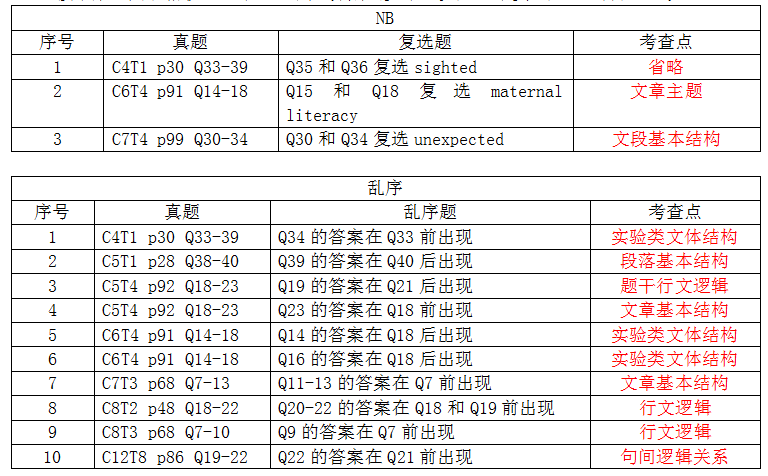
作者:新航道武汉学校雅思阅读组 金军
雅思阅读备考过程中,关于选项式summary(即,summary with a box)题目,考生常问到几个问题。要求中NB是什么意思?为什么会出现NB?这类题型中会有乱序吗?这里考查什么呢?
这些问题的出现,也集中反映出这类题型的两个特点,也是难点。
(1)NB You may use any word more than once.
(2)顺序中的乱序
如何正确理解这两个特点在备考中的意义,我们先来看统计自剑桥真题4-14的几个数据:
(1)选项式summary:20套题
(2)NB出现次数:3次
(3)乱序出现次数:8套题,或10小题
接下来,用表格梳理一下,让我们分别浏览下这类题型中复选题和乱序题的考查点。

我们进一步具体细查各个此类小题的究竟。
(1)C4T1 p30 Q33-39
NB
Q35和Q36复选sighted
Q35:定位到最后一段All our subjects deemed the circle soft and the square hard. 而all our subjects指代上一段的sighted subjects。这个填空考查指代关系。
Q36:定位到最后一段And only 51% linked deep to circle and shallow to square. 这里only 51%后省略了前述提到的实验对象,也就是上一题的sighted subjects。这里的复选考查的是省略。
乱序
Q34的答案在Q33前出现
Q33:定位到倒数第二段We gave a list of twenty pairs of words…
Q34:定位到倒数第三段I have begun exploring how well blind people understand the symbolism behind shapes such as hearts that do not directly represent their meaning. 这里Q34答案出现在Q33前,是因为提干a set of word pairs was used属于实验类文体实验准备中的工具内容,而紧接着to investigate whether…属于实验目的的内容。而原文中是先说的目的、再说的工具,所以乱序。这里考查的是对于实验类文体结构的理解。
(2)C5T1 p28 Q38-40
乱序
Q39的答案在Q40后出现
Q40:定位到倒数第二段…the cost of solving the world’s single, most pressing health problem…
Q39:提干中…it will not have a catastrophic impact on out future, if we deal with it in the …… way. 这句话相对于后续内容是一个概述性表达,对应原文的段落最后一句结论性表达Such measures would avoid 2 million deaths every year, and prevent half a billion people from becoming seriously ill. 所以这里的乱序考查的是对于段落基本结构的理解。
(3)C5T4 p92 Q18-23
乱序
Q19的答案在Q21后出现
Q19:题干However, it has one disadvantage: it can shatter …… 根据关键词定位不回原文。再仔细比对文章标题Flawed Beauty: the problem with toughened glass发现,Q19考查的内容实际跟文章主题相关。但是继续读题干发现,后续有一处However, if the glass contains nickel sulphide impurities, crystals of nickel sulphide are formed. These are unstable…在行文逻辑上跟Q19所在的句子是呼应的,都在谈钢化玻璃的缺点或问题。这道题考查的是对于题干行文逻辑的把握。
Q23的答案在Q18前出现
Q23:通过对于提干语义的理解以及结合词库,判断出这里需要得出玻璃专家对于问题发生频率的观点是否一致的信息,但是在Q22后续文章剩下的最后两段没有相关信息。实际上答案在做Q18时跳过的文章前三段中,也即第三段Others disagree. 回应的第二段最后一句话It’s a very rare phenomenon, he says. 这一题涉及文章结论性表达,实际在文章最开始的概述性表达中查找。这道题考查的是对于文章基本结构的理解。
(4)C6T4 p91 Q14-18
NB
Q15和Q18复选maternal literacy
Q15:定位到段Experts in public health accepted this idea decades ago…
Q18:定位到第二段…showing that teaching reading to poor adult women…这里复选是因为问的都是涉及的两个研究对象之一母亲识字能力,只是一个是在研究背景部分,一个是在研究结论部分。这里复选考查的是对于文章主题的把握。
乱序
Q14的答案在Q18后出现
Q14:定位到第三段…about 300,000 illiterate adults from all over the country, many of whom had never attended primary school, had learnt how to read, write and use numbers.这里说的是研究对象
Q18:定位到第二段…showing that teaching reading to poor adult women…这里说的是研究结论。出现乱序是因为提干先呈现研究对象,最后呈现研究结论;而原文是先呈现研究结论,再呈现研究对象等细节。这里考查的是对于实验类文体结构的理解。
Q16的答案在Q18后出现
Q16:定位到第四段…the National Autonomous University of Nicaraguan and the Costa Rican Institute of Health interviewed…这里说的是研究者。出现乱序是因为提干先呈现研究者,再呈现研究结论;而原文是先呈现研究结论,再呈现研究者。这里考查的是对于实验类文体结构的理解。
(5)C7T3 p68 Q7-13
乱序
Q11-13的答案在Q7前出现
Q11-13:定位到第四段。乱序是因为提干中这三个题所在句子In fact…具备总结句的特征。而这个在Q10对应原文的后续内容没有相关信息。这个信息实际在Q7对应原文内容之前,以概述性表达呈现。这里考查的是对于文章基本结构的理解。
(6)C7T4 p99 Q30-34
NB
Q30和Q34复选unexpected
Q30:定位到第三段...than to work under circumstances with unexpected intrusions of noise.
Q34:定位到第四段...Apparently, unpredictable noise produces more fatigue than predictable noise...这里出现复选是因为,Q30对应的内容是呈现研究结论,而Q30对应的内容是重申研究结论。这里考查的是对于文段基本结构的理解。
(7)C8T2 p48 Q18-22
乱序
Q20-22的答案在Q18和Q19前出现
Q18和Q19:定位到C段。
Q20-22:定位到B段。这里Q18和Q19的内容是记录方式。Q20-22的内容是记录的自然现象。出现乱序是因为题干先呈现记录方式,再呈现记录的自然现象。而原文正好反过来。这里考查的是行文逻辑的理解。
(8)C8T3 p68 Q7-10
乱序
Q9的答案在Q7前出现
Q7:定位到第六段when high-powered lasers were revealing their ability to extract electrons out of atoms and create ions.
Q9:定位到第五段And anyway, who would want to fire streams of rockets in a populated area?这里出现乱序是因为,题干中Q9的内容存在于than using......中,是一个比较对象,而这个比较对象在原文引出lasers这个新方法之前呈现。这里考查的是对于行文逻辑的理解。
(9)C12T8 p86 Q19-22
乱序
Q22的答案在Q21前出现
Q21:定位到第七段...presents little risk to sheep and other livestock.
Q22:定位到第七段...the aim of bringing forests back to parts of our bare and barren uplands.这里出现乱序是因为Q22题干是Furthermore,...原文中出现在Q21对应原文前面,是将这里的递进关系理解为并列关系,倒序并不影响语义。这里考查的是句间逻辑关系。
综上所查,一句话,选项式summary题型中如果出现NB和乱序,一定是在更大的语义单位层面(即,多句关系、段落结构以及文章结构等)考查阅读理解能力。
最后,让我们一起回顾一下OG上对于summary题型的提示,可以看出考查能力的一些呼应点。
A summary is different from a set of notes, because it consists of complete sentences that are connected together grammatically. You need to
1. carefully read and understand the summary.
2. decide what type of word is needed to complete each gap in the summary.
3. locate and carefully read the relevant part of the passage.
4. choose the word or phrase (either from a box of answers or from the passage) that accurately fills each gap.